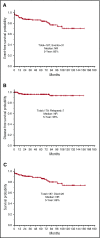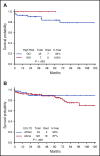Long-term outcome of acute promyelocytic leukemia treated with all- trans-retinoic acid, arsenic trioxide, and gemtuzumab
- PMID: 28003274
- PMCID: PMC5413297
- DOI: 10.1182/blood-2016-09-736686
Long-term outcome of acute promyelocytic leukemia treated with all- trans-retinoic acid, arsenic trioxide, and gemtuzumab
Abstract
The combination of all-trans-retinoic acid (ATRA) plus arsenic trioxide (ATO) has been shown to be superior to ATRA plus chemotherapy in the treatment of standard-risk patients with newly diagnosed acute promyelocytic leukemia (APL). A recent study demonstrated the efficacy of this regimen with added gemtuzumab ozogamicin (GO) in high-risk patients. We examined the long-term outcome of patients with newly diagnosed APL treated at our institution on 3 consecutive prospective clinical trials, using the combination of ATRA and ATO, with or without GO. For induction, all patients received ATRA (45 mg/m2 daily) and ATO (0.15 mg/kg daily) with a dose of GO (9 mg/m2 on day 1) added to high-risk patients (white blood cell count, >10 × 109/L), as well as low-risk patients who experienced leukocytosis during induction. Once in complete remission, patients received 4 cycles of ATRA plus ATO consolidation. One hundred eighty-seven patients, including 54 with high-risk and 133 with low-risk disease, have been treated. The complete remission rate was 96% (52 of 54 in high-risk and 127 of 133 in low-risk patients). Induction mortality was 4%, with only 7 relapses. Among low-risk patients, 60 patients (45%) required either GO or idarubicin for leukocytosis. Median duration of follow-up was 47.6 months. The 5-year event-free, disease-free, and overall survival rates are 85%, 96%, and 88%, respectively. Late hematological relapses beyond 1 year occurred in 3 patients. Fourteen deaths occurred beyond 1 year; 12 were related to other causes. This study confirms the durability of responses with this regimen.
© 2017 by The American Society of Hematology.
Figures






Comment in
-
From occasional date to civil union in APL.Blood. 2017 Mar 9;129(10):1235. doi: 10.1182/blood-2017-01-759761. Blood. 2017. PMID: 28280041 No abstract available.
References
-
- Sanz MA, Martín G, González M, et al. ; Programa de Estudio y Traitmiento de las Hemopatías Malignas. Risk-adapted treatment of acute promyelocytic leukemia with all-trans-retinoic acid and anthracycline monochemotherapy: a multicenter study by the PETHEMA group. Blood. 2004;103(4):1237-1243. - PubMed
-
- Adès L, Chevret S, Raffoux E, et al. ; European Acute Promyelocytic Leukemia Group. Is cytarabine useful in the treatment of acute promyelocytic leukemia? Results of a randomized trial from the European Acute Promyelocytic Leukemia Group. J Clin Oncol. 2006;24(36):5703-5710. - PubMed
-
- Wang ZY, Chen Z. Acute promyelocytic leukemia: from highly fatal to highly curable. Blood. 2008;111(5):2505-2515. - PubMed
-
- Fenaux P, Le Deley MC, Castaigne S, et al. Effect of all transretinoic acid in newly diagnosed acute promyelocytic leukemia. Results of a multicenter randomized trial. European APL 91 Group. Blood. 1993;82(11):3241-3249. - PubMed
Publication types
MeSH terms
Substances
Grants and funding
LinkOut - more resources
Full Text Sources
Other Literature Sources
Medical

